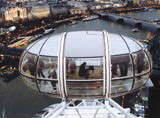Design credited for rise in visitors to attractions

Well-designed attractions are proving a bigger crowd puller than heritage as Britain’s modern tourist attractions continue to win the largest share of visitors, according to a report released this week by the English Tourism Council.
The report highlights soaring visitor numbers at modern attractions like the British Airways London Eye (pictured), Windsor’s Legoland and the Eden Project in St Austell, despite one of the worst years on record for UK tourism.
ETC chief executive Mary Lynch says the ability to capture public imagination through outstanding design, which extends beyond the venue itself to the functionality of visitor facilities, is key to the appeal of modern landmarks.
‘Visitors have a keen sense of innovation and instinctively recognise good design. People do not consciously consider whether one attraction is better designed than another, but on a subconscious level it is certainly a factor in the decision process,’ says Lynch.
This is where the London Eye and Eden Project have the edge over traditional venues, argues Lynch, who believes tourists to historic buildings ‘don’t want a 12th century experience’ when visiting the toilet, souvenir shop or café.
According to the report, the London Eye generated 3.85 million visits and the Eden Project 1.7 million in their first full year of operation. Legoland Windsor enjoyed a 9.5 per cent jump in visitors.
But traditional venues such as Windsor Castle and Westminster Abbey have seen visitor figures plummet. Both suffered a 20 percent slide, says the report.
Land creative director Peter Higgins says successful projects owe their magnetism to the overarching vision of design teams which steered the projects from inception to launch.
‘Designers of modern attractions start with a vision and carry that through from planning architecture to creating marketing materials and signage,’ explains Higgins.
In contrast, the Tower of London has lost its way because there is no overall vision, says Higgins, who believes historic buildings struggle to make heritage appealing to tourists.
But Museums Association policy officer Helen Wilkinson argues that attractions like the London Eye are basking in a honeymoon period which guarantees high numbers through the turnstiles. She says the bubble may burst when visitors start looking beyond the visually stunning design.
Citing the Tate Modern and Wellcome Wing at the Science Museum, Wilkinson insists the sector commands a more enduring ‘wow’ factor that isn’t limited to first impressions.
‘Museums and galleries offer multiple experiences in terms of the depth of displays on offer, quality of information and input from staff. Design obviously creates an impression, but it’s just one element in the overall encounter.
With the London Eye the experience stops at the design and thrill of the ride. In contrast, the Tate Modern is securing consistently high repeat visits because the public is interested in more than the building design,’ she adds.
-
Post a comment



